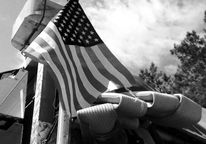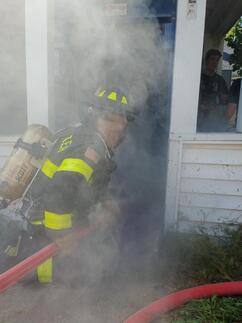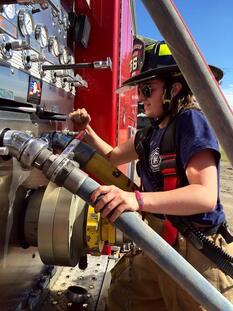
SMFR believes that training never ends for emergency personnel. Our strategic training program incorporates all aspects of any incident we could be called to respond to. Through lectures, active alumni instructors, and joint trainings, we ensure that all of our members are more than prepared to provide the highest level of emergency care and service. The fire unit completes a minimum of three trainings a week including trainings led by the Colchester Fire Department, Winooski Fire Department, and in house trainings led by the unit 1st Lieutenant.
Rookie Class
|
Rookies learn the basics of fire and rescue skills through a series of lectures and practical trainings taught by current and alumni members of the department and county departments. Rookies also learn the basic, but most important, everyday tasks such as checking air packs and equipment.
Upon succesful completion of the County Basic Firefighter Class - which is based heavily on the Vermont Firefighter I course - rookies are given the opportunity to test on the skills learned thus far. Once they pass this test, they officially join the department as probationary members. The test includes a written portion and practical skills such as knowledge of tools and extinguishers, ladders, knots, and hose line advancement.
|
Probate Class
Upon passing the rookie test and being voted up, members will enter a four-month probationary period and will be assigned a company - a group composed of an officer, driver, and senior members - with whom they will attend calls. Probationary members begin as exterior members and may be assigned the task of dressing a hydrant at fires and alarms, and any exterior operations at car accidents, fires, or any other incident.
During this time, they continue their training two times a week in a course designed specifically for the way SMFR operates, as well as training with the rest of the department an additional two days a week. Near the middle of their probationary period, members will test to become interior members. This timed endurance test includes skills that directly relate to fireground operations such as victim drags, hose line advancement, and ladders.
To become senior members, an individual must pass a more extensive written and practical test and be voted up by the current membership. Before becoming senior members, they will become certified in CPR, at the HazMat operations level, and at the NIMS 100, 200, 700 and 800 level.
During this time, they continue their training two times a week in a course designed specifically for the way SMFR operates, as well as training with the rest of the department an additional two days a week. Near the middle of their probationary period, members will test to become interior members. This timed endurance test includes skills that directly relate to fireground operations such as victim drags, hose line advancement, and ladders.
To become senior members, an individual must pass a more extensive written and practical test and be voted up by the current membership. Before becoming senior members, they will become certified in CPR, at the HazMat operations level, and at the NIMS 100, 200, 700 and 800 level.
Fire Unit TrainingSenior and probationary members train officially twice a week - on Wednesdays with the Colchester Fire Department and on Fridays with exclusively the Saint Michael's Fire Unit. These trainings include advanced skills such as victim extrication at motor vehicle accidents, roof operations, and water supply. Members also train with the Winooski Fire Department on a quarterly basis.
Training switches between focusing on particular skills to full-scale incident scenarios to ensure the highest level of application of these advanced skills. |
Riding Positions
BACK OF THE CAB: Members riding in the back of the cab will be a mix of senior and probationary members. These members may take on any task that an incident calls for. On fire alarms they will form investigation teams and search buildings for hazards and activated alarms. At motor vehicle accidents they will complete vehicle stabilization, victim extrication, fluid clean-up, psychological first aid, and primary patient care if certified. At fire scenes they will form divisional fire attack teams, operational search and venting teams, and any other necessary functions.
ENGINE OFFICER: The engine officer is usually a Fire Unit officer such as a Lieutenant or Captain, but may be the most senior member depending on who is responding. The engine officer sits in the front right seat of the engine and is responsible for the successful overall operation of the unit on calls. As one of the most experienced and proficient members of the responding members, the engine officer is expected to act as a leader to the crew and a representative to other departments.
The specific role of the engine officer varies depending on the town they are responding to and the ranks of other responding officers. In general the engine officer will take command of an incident and act as the liason between the crews working inside a building and incoming units, ordering tasks to be completed, and relaying major changes to all units not on scene.
The specific role of the engine officer varies depending on the town they are responding to and the ranks of other responding officers. In general the engine officer will take command of an incident and act as the liason between the crews working inside a building and incoming units, ordering tasks to be completed, and relaying major changes to all units not on scene.
|
DRIVER: The driver is in charge of the safe and efficient arrival of the crew to the scene and the positioning of the apparatus to allow for the arrival of incoming apparatus, the safety of the scene, and traffic flow when possible. The driver's main role is pump operator, and is responsible for water supply during fire-related incidents. The driver is occasionally the liaison between the equipment on the truck and the scene, making trips back and forth to shuttle necessary items.
Acting as the crew member that is not directly involved with interior operations, the driver adds another set of eyes to the overall scene and sometimes an extra set of hands, as they can perform some exterior operations such as ladder placement and horizontal ventilation as needed.
To become a driver, an individual must complete an intensive training program that requires a candidate to complete a requisite number of "on the road" driving hours and pump operation hours, as well as memorization of roads and landmarks in the unit's service area. As driving is commonly the most dangerous aspect of a call, drivers are held to a high standard of proficiency and knowledge in every skill before they are allowed to drive. |







